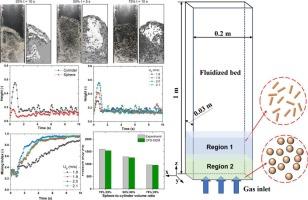流化床中超四边形颗粒二元混合物的床层动力学 CFD-DEM 模拟研究
IF 4.5
2区 工程技术
Q2 ENGINEERING, CHEMICAL
引用次数: 0
摘要
在热解和气化等生物质热转化过程中,生物质通常呈圆柱形。然而,以往的研究大多将生物质建模为球形,对非球形生物质颗粒与近似球形床层材料的流化和混合行为探讨不足。为了弥补这一不足,我们采用了超二次粒子模型与 CFD-DEM 相结合的方法来探索非球形二元混合物的流化特性和混合动力学。数值模型成功验证了二元混合物内的压降和空间分布。结果表明,颗粒混合主要由气泡的上升和运动驱动。圆柱形颗粒的高宽比与二维矩形流化床的窄厚度相结合,在流化过程中产生了显著的互锁效应。这种交错既阻碍了流化,也阻碍了混合,导致非球形颗粒的整体性能不佳。在较低的表面速度(Ug)下,由于中心气泡的上升,只有下部的圆柱形颗粒被流化。当表层速度(Ug)上升到较高值时,两种颗粒类型实现了有效混合。当 Ug 从 1.8 m/s 上升到 2.1 m/s 时,混合指数从 0.78 上升到 0.94。然而,圆柱形颗粒的堆叠模式在床底形成了一个死区,仅由球形颗粒占据,这限制了床层的局部混合和流化。随着 Ug 从 1.8 m/s 增加到 2.1 m/s,无量纲库存高度从 0.6 增加到 1.0,圆柱的轴向分散系数分别从 1.17×10-3 m2/s 增加到 4.35×10-3 m2/s 和从 1.91×10-3 m2/s 增加到 9.22×10-3 m2/s。这项研究为非球形颗粒的行为提供了新的见解,为优化化学工程工艺提供了潜在的途径。本文章由计算机程序翻译,如有差异,请以英文原文为准。

CFD-DEM simulation study on the bed dynamics of a binary mixture with super-quadric particles in a fluidized bed
In biomass thermal conversion processes such as pyrolysis and gasification, biomass often takes on a cylindrical shape. However, most previous studies have modeled biomass as spherical, leaving the fluidization and mixing behaviors of non-spherical biomass particles with approximately spherical bed materials insufficiently explored. To bridge this gap, a super-quadratic particle model coupled with CFD-DEM was used to explore the fluidization characteristics and mixing dynamics of non-spherical binary mixtures. The numerical model successfully validated the pressure drop and spatial distribution within the binary mixture. The results indicate that particle mixing is primarily driven by the rise and movement of bubbles. The large aspect ratio of the cylindrical particles, combined with the narrow thickness of the 2D rectangular fluidized bed, leads to a significant interlocking effect during fluidization. This interlocking hinders both fluidization and mixing, resulting in poor overall performance for non-spherical particles. At a low superficial velocity (Ug), only the cylindrical particles in the lower part are fluidized as a result of the rising central bubble. The two particle types achieve effective mixing as the Ug rises to a high value. The mixing index increases from 0.78 to 0.94 as the Ug increases from 1.8 to 2.1 m/s. However, the stacking pattern of cylindrical particles creates a dead zone at the bed bottom, occupied solely by spherical particles, which limits local bed mixing and fluidization. As the Ug increases from 1.8 to 2.1 m/s and the dimensionless inventory height increases from 0.6 to 1.0, the axial dispersion coefficient of the cylinders increases from 1.1710−3 to 4.3510−3 m2/s and from 1.9110−3 to 9.2210−3 m2/s, respectively. This study provides new insights into the behavior of non-spherical particles, offering potential avenues for optimizing chemical engineering processes.
求助全文
通过发布文献求助,成功后即可免费获取论文全文。
去求助
来源期刊

Powder Technology
工程技术-工程:化工
CiteScore
9.90
自引率
15.40%
发文量
1047
审稿时长
46 days
期刊介绍:
Powder Technology is an International Journal on the Science and Technology of Wet and Dry Particulate Systems. Powder Technology publishes papers on all aspects of the formation of particles and their characterisation and on the study of systems containing particulate solids. No limitation is imposed on the size of the particles, which may range from nanometre scale, as in pigments or aerosols, to that of mined or quarried materials. The following list of topics is not intended to be comprehensive, but rather to indicate typical subjects which fall within the scope of the journal's interests:
Formation and synthesis of particles by precipitation and other methods.
Modification of particles by agglomeration, coating, comminution and attrition.
Characterisation of the size, shape, surface area, pore structure and strength of particles and agglomerates (including the origins and effects of inter particle forces).
Packing, failure, flow and permeability of assemblies of particles.
Particle-particle interactions and suspension rheology.
Handling and processing operations such as slurry flow, fluidization, pneumatic conveying.
Interactions between particles and their environment, including delivery of particulate products to the body.
Applications of particle technology in production of pharmaceuticals, chemicals, foods, pigments, structural, and functional materials and in environmental and energy related matters.
For materials-oriented contributions we are looking for articles revealing the effect of particle/powder characteristics (size, morphology and composition, in that order) on material performance or functionality and, ideally, comparison to any industrial standard.
 求助内容:
求助内容: 应助结果提醒方式:
应助结果提醒方式:


